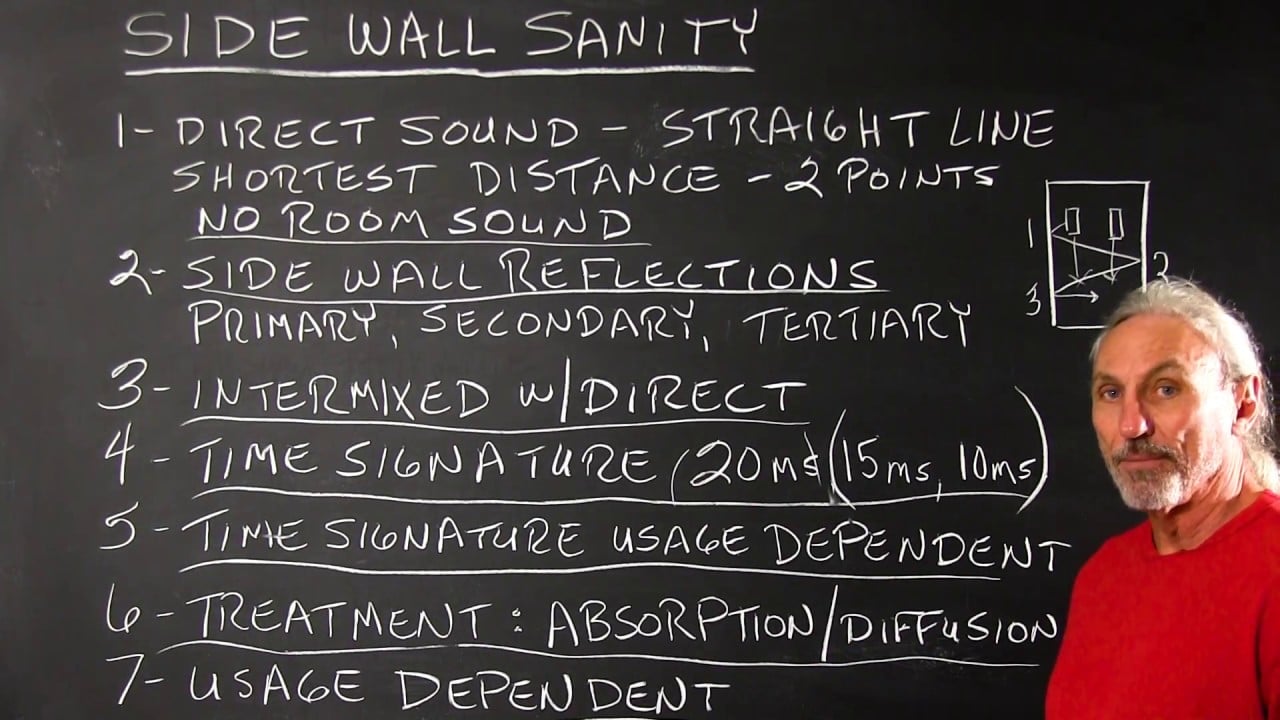Let’s talk about side walls and the insanity or sanity if you will of them and how important they are into what we here at the listening or monitoring position. Of course we know from our past discussions that direct sound is that straight line energy from our speakers and that’s the most important sound because that’s the purest, shortest distance between two points sounds so no reflections, no room sound in it.
So the big thing about this is that we have to realize we’ve got to balance the direct energy from what we have here which is the side wall reflections. Now the side wall reflections we know have three main parts to them, not just primary I know a lot of you understand the primary reflection which is the first reflection off the closest room boundary surface from your speakers. That’s very important but another very important one is that primary reflection traveling across to the opposite wall then it becomes secondary and then the secondary travels across to its originating wall and becomes a tertiary reflection. So it’s those three signatures that are very very important all created by the side wall so we have to be very very careful with them.
Now the balancing act that we have to do is we have to intermix those reflected sounds with the direct sound, now do we want to eliminate the reflected sound completely? No we want to balance it with the direct from our loudspeakers and here’s where the time signature of the reflection comes into play, there’s a lot of talk in the literature, there’s a lot of discussion amongst people about what the exact time signature should be below the direct of the reflected energy. Some of the literature will say 20 milliseconds, some will say 15, and some will say 10. The real answer to this question is it is usage dependent so if you’re in a control room and you’re in a situation where everything is critical and you want to be able to hear everything, you want to hear all the definition, all the separation and everything that goes with it then we want a lower time signature window. When we do our critical listening rooms where resolution is a key we usually stay right into this 15 to 10 millisecond range and it varies depending on room size so it’s very dependent on what you’re doing. 20 is good if you want a really nice broad soundstage and you have the volume in the room to do it but you want to narrow the window of that reflection, the time signature of that reflection for a more focused critical listening situation all right.
What are our treatment options? Well we only have two, I wish we could think of a third but there are none, I mean we could say reflections but we’re trying to minimize those so… Absorption and diffusion are our only two technologies and both of those technologies are usage dependent and you know from my past videos that depending on what you’re trying to do in the room it’s very important to get the treatment right to match the usage. So absorption is good for critical listening because you get good definition but you have to use the proper rates and levels. Diffusion is good if you want to spread things out, have a wider soundstage and create this larger-than-life sense in a smaller room so diffusion can help you with that. So side wall reflections, it’s a balancing act between the direct and the reflected energy from the room, mainly the primary, secondary and tertiary reflections and our time signatures are dependent on our usage.
—
This is an unedited transcript from our video series from Acoustic Fields. There will be some errors in grammar and sentence structure that occur during this translation process.
For complete understanding and comprehension, please view the video which is included in this text. For any additional information regarding this topic or others relating to room acoustics, please contact us directly at:
P: 520 – 392 – 9486







